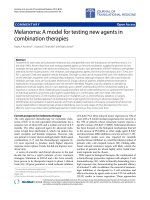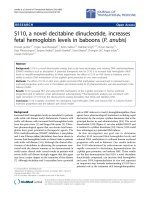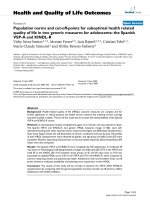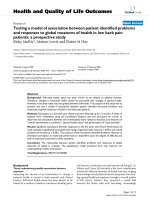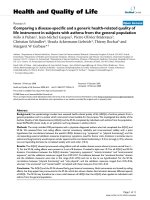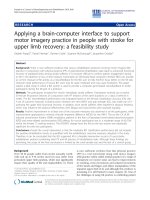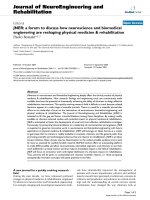báo cáo hóa học:" Defining a minimal clinically important difference for endometriosis-associated pelvic pain measured on a visual analog scale: analyses of two placebo-controlled, randomized trials" pptx
Bạn đang xem bản rút gọn của tài liệu. Xem và tải ngay bản đầy đủ của tài liệu tại đây (357.57 KB, 7 trang )
RESEARC H Open Access
Defining a minimal clinically important difference
for endometriosis-associated pelvic pain
measured on a visual analog scale: analyses of
two placebo-controlled, randomized trials
Christoph Gerlinger
1*
, Ulrike Schumacher
2
, Thomas Faustmann
3
, Antje Colligs
4
, Heinz Schmitz
5
, Christian Seitz
5
Abstract
Background: When comparing active treatments, a non-inferiority (or one-sided equivalence) study design is often
used. This design requires the definition of a non-inferiority margin, the threshold value of clinical relevance. In
recent studies, a non-inferiority margin of 15 mm has been used for the change in endometriosis-associated pelvic
pain (EAPP) on a visual analog scale (VAS). However, this value was derived from other chronic painful conditions
and its validation in EAPP was lacking.
Methods: Data were analyzed from two placebo-controlled studies of active treatments in endometriosis,
including 281 patients with laparoscopically-confirmed endometriosis and moderate-to-severe EAPP. Patients
recorded EAPP on a VAS at baseline and the end of treatment. Patients also assessed their satisfaction with
treatment on a modified Clinical Global Impression scale. Changes in VAS score were compared with patients’ self-
assessments to derive an empirically validated non-inferiority margin. This anchor-based value was compared to a
non-inferiority margin derived using the conventional half standard deviation rule for minimal clinically important
difference (MCID) in patient-reported outcomes.
Results: Anchor-based and distribution-based MCIDs were-7.8 mm and-8.6 mm, respectively.
Conclusions: An empirically validated non-inferiority margin of 10 mm for EAPP measured on a VAS is appropriate
to compare treatments in endometriosis.
Introduction
Endometriosis is a common condition in women of
reproductive age that is characterized by the presence of
functional endometrium-like tissue outside the uterus
(e.g., the ovaries and other pelvic structures). Changes
in the number and size of such endometriotic lesions
were often used to assess the efficacy of treatment
options for endometriosis [1-4]. However, there is no
direct correlation between the extent of these lesions
and the severity of the sympt oms experienced by the
patient [5-7]. Potential explanatio ns for this lack of cor-
relation are that the level of pain induced by endome-
triosis might be determined by the depth of tissue
intrusion of a specific lesion, or that there may be a
direct interaction of endometriotic lesions and nerve
fibers [8,9]. Neither of these potential explanations can
be assessed by visual inspection during surgery and are
therefore not reflected in the respective scoring systems
for endometriosis severity [10,11].
Typical symptoms of endometrio sis include dysmenor-
rhea, dyspareunia, and chronic pelvic pain [12-14]. Pain is
commonly considered the most relevant symptom and the
primary reason for treatment [14,15]. Different tools for
assessing pain in endometriosis, such as the visual analog
scale (VAS) or numerical rating scales, have been used in
the past. Recommendations on how to assess endometrio-
sis-related symptoms in a way that allows for comparison
of results between clinical trials have recently been pub-
lished [16]. However, publications on the validity of the
* Correspondence:
1
Global Clinical Statistics, Bayer Schering Pharma AG, 13342 Berlin, Germany
Full list of author information is available at the end of the article
Gerlinger et al. Health and Quality of Life Outcomes 2010, 8:138
/>© 2010 Gerlinger et al; licensee BioMed Central Ltd. This is a n Open Access article distributed under the terms of the Creative
Commons Attribution License ( which permits unrestricted use, distribution, and
reproduction in any medium, provided the original work is properly cited.
pain and quality-of-life scales for use in endometriosis are
still scarce and information on the psychomet ric proper-
ties of such tools in the indication of endometriosis are
generally lacking [17,18].
When comparing the efficacy of different active treat-
ments in endomet riosis-associated pelvic pain (EAPP), a
non-inferiorit y-also called a one-sided equivalence-study
design is often used. This is because a new treatment
modality might provide a benefit for the patient (e.g.,
better tolerability and/or safety) even if it is not superior
to existing treatments with regard to efficacy [19-21].
The methodological principles for the non-inferiority
trial design are described in the International Confer-
ence on Harmonisation guideline E10 [22]. The design
of a non-inferiority study requires the a priori definition
of a non-inferiority margin, often called delta, which
describes the threshold value of clinical relevance.
There are clinical and statistical aspects to be consid-
ered when choosing a non-inferiority margin [23]. The
major clinical requirement for choosing a non-inferiority
margin is that any treatme nt difference smaller than the
non-inferiority margin should not be of clinical rele-
vance. The major statistical requirement for choosing a
non-inferiority margin is that the non-inferiority margin
is small enough to exclude the effect of placebo. The
focus of this paper is to empirically define the threshold
value of clinical relevance for EAPP measured on a VAS
that fulfils these criteria. It should be noted that the
definition of the clinically relevant threshold is indepen-
dent of the dif ference between a given treatment and
placebo. However, exclusion of t he placebo effect needs
to be considered when applying the threshold value of
clinical relevance in a clinical trial.
The data for this paper derive from two recent rando-
mized, placebo-controlled clinical trials in EAPP. Both
trials used a very similar design, which is reported else-
where [24]. The patients recorded their EAPP on a VAS
at screening, baseline, during, and at the end of treatment
(week 12). At the end of the treatment, patients also
rated their satisfaction with treatment using a modifica-
tion of the Clinical Global Impression (CGI) scale-global
improvement item [25]. This simple and well-establi shed
tool for the assessment of overall treatment effect was
used as an anchor for the definition of the minimal clini-
cally important difference (MCID) for EAPP.
Methods
Study design
These two international, randomized, double-blind, pla-
cebo-controlled studies investigated the efficacy and
safety of two different compounds in the treatment of
endometriosis.
Study 1 was conducted at 33 centers in Germany (n =
19), Italy (n = 8), and Ukraine (n = 6). Study 2 was
conducted at 28 centers in the Czech Republic (n = 4),
Denmark (n = 2), Spain (n = 6), Finland (n = 6), France
(n = 1), The Netherlands (n = 3), and Sweden (n = 6).
The study protocols were approved by local independent
Ethics Committees and all participants provided written
informed consent before study enrollment. The studies
were conducted in accordance with the amended ver-
sion of the Declaration o f Helsinki and complied with
Good Clinical Practice.
Patients
Womenaged18to45years,betweenmenarcheand
menopause and in good general health except for endo-
metriosis, were eligible for study inclusion (Table 1).
Inclusion criteria included endometriosis stage I-IV,
according t o revised American Society of Reproductive
Medicine (r-ASRM) scoring [11], which was assessed at
diagnostic laparoscopy within 12 months prior to study
baseline. Patients were required at both screening and
baseline to have an EAPP score of ≥ 30 mm (study 1) or
≥ 40 mm (study 2) on a VAS, where the anchor points
were 0 mm (representing absence of pain) and 100 mm
(indicating unbearable pain), without intervening mark -
ings (Figure 1).
Exclusion criteria included pregnancy or breastfeeding,
use of an intrauterine device, amenorrhea within 3
months of screening, signs o r symptoms of therapy-
resistant endometriosis or need for near-term surgical
treatment of endometriosis, previous use of hormonal
age nts (e.g., gonadotropin-relea sing hormone agonists ≤
6 months before screening, progestins or danazol ≤ 3
months before screening, or oral contraceptives ≤ 1
month before screening), clinically relevant findings at
gynecological examination, or an abnormal cervical
cytological smear in the last 3 months.
Of 308 women with moderate-to-severe EAPP rando-
mized in the two studies, 281 provided data on the CGI
scale and change in EAPP.
Efficacy endpoints
The primary efficacy variable in both studies was the
absolute change in EAPP from baseline to the end of
Table 1 Patient demographics
Total number of patients, n (%) 281 (100)
Ethnic group, n (%)
Caucasian 278 (98.9)
Black 1 (0.4)
Asian 2 (0.7)
Age (years), mean (SD) 31.9 (6.4)
Weight (kg), mean (SD) 63.0 (10.8)
Body mass index (kg/m²), mean (SD) 22.8 (3.7)
SD, standard deviation
Gerlinger et al. Health and Quality of Life Outcomes 2010, 8:138
/>Page 2 of 7
treatment. EAPP was evaluated at weeks 0, 4, 8, and 12
by assessment of pain score on the VAS and intake of
supportive analgesic medication (ibuprofen tablets) for
pelvic pain.
Secondary efficacy variables included, among othe rs, a
global assessment of efficacy by patients and investiga-
tors using the CGI scale-global improvement item [25]
(Table 2), which was applied at the end of treatment.
Statistical methods
Following the intent-to-treat approac h, all randomized
patients who provided data were included in the ana-
lyses, regardless of possible protocol deviations.
EAPP was recorded by patients on a VAS before (at
screening and baseline), during, and at the end of treat-
ment. From these measurements, the individual absolute
change in EAPP was derived by subtracting the baseline
VAS score from the VAS score at end of treatment. At
the end of treatment, patients also rated their overall
satisfaction using the CGI scale-global improvement
item. For one patient, a missing assessment was replaced
by the corresponding physician’ s assessment, because
these two ratings showed substantial agreement
(weighted coefficient 0.69, n = 294; 95% confidence
interval [CI] 0.64-0. 75), according to the definition of
Landis and Koch [26]. Missing VAS scores were not
imputed. In cases where patients dropped out prema-
turely, the last available measurement under treatment
was included in the analysis (last value carried forward
method).
All variables were analyzed by descriptive statistics,
either by absol ute and rel ative frequencies for discrete
data, or by the number of non-missing observations,
mean, standard deviation, minimum, 25th percentile,
median, 75th percentile, and maximum for metric data.
Given that several ca tegories on the seve n-point GCI
scale were rarely ticked by the women (see Table 2), t he
scale was aggregated to a three-point scale for further ana-
lyses. The entries “very much satisfied” and “much satis-
fied” were merged into “satisfied” and the entries “neither
satisfied nor dissatisfied” to “very much dissatisfied” were
merged into “undecided or worse”, whereas the cat egory
“ minimally satisfied” was left unchanged. These three
resulting categories were of approximately equal size and
there were no relevant differences in the VAS scores for
the categories merged. This one-sided approach was used
because the patients reporting themselves as “neither satis-
fied nor dissatisfied” showed, on average, a slight improve-
ment of their VAS scores and because this approach also
conserved the direction of the changes.
A bidirectional approach was additionally added as a
sensitivity analysis, with the assumption that patients
rate an increase in pain in the same way as a reduction
in pain. For this analysis, the CGI categories were
grouped into the three categories: “ much change”
(including the categories “very much satisfied”, “much
satisfied”, “much dissatisfied”,and“very much dissatis-
fied”), “minimal change ” (including the categories “mini-
mally satisfied” and “minimally dissatisfied” ), and
“no
change” (the remaining CGI category “neither satisfied
nor dissatisfied” ). VAS score changes for satisfied
patients (who were assumed to have a reduction in
pain) were multiplied by-1 for this analysis.
Boxplots were drawn using the 10th and 90th percen-
tile as endpoints of the whiskers. Outlying observations
were also shown, using a dot as the plot symbol. A non-
parametric discriminant analysis with normal kernels
and unequal bandwidths [27] was performed. A one-way
analysis of variance (ANOVA) of the changes in VAS
score with factor grouped CGI category was performed
to estimate the mean differences and their 95% confi-
dence intervals. All statistical analyses were performed
using version 9.1 of SAS software [28], running under
Windows XP Professional.
Figure 1 The VAS. Patients record the severity of their pain on a VAS score from 0 mm to 100 mm.
Table 2 Subjects’ assessments on the CGI scale-global
improvement item (n, %)
CGI scale Aggregated CGI scale
Very much satisfied 18 (6.4) Satisfied 108
(38.4)
Much satisfied 90 (32.0)
Minimally satisfied 101
(35.9)
Minimally satisfied 101
(35.9)
Neither satisfied nor
dissatisfied
50 (17.8) Undecided or
worse
72 (25.6)
Minimally dissatisfied 14 (5.0)
Much dissatisfied 7 (2.5)
Very much dissatisfied 1 (0.4)
Gerlinger et al. Health and Quality of Life Outcomes 2010, 8:138
/>Page 3 of 7
Results
Demography
Of the 308 women randomized in the two studies, 281
(91.2%)provideddatabothontheCGIscaleandon
their change in pelvic pain and were included in this
analysis. Almost all of these women were Caucasian,
with a mean age of 32 years and a mean body mass
index of 23 kg/m² (Table 1).
CGI scale-global improvement item
The global efficacy assessment (Table 2) showed that
108 (38.4%) of the women were at least “much satisfied”,
101 (35.9%) were “minimally satisfied” ,and22(7.8%)
were “minimally dissatisfied” or worse with their treat-
ment. The remaining 50 (17.8%) women rated them-
selves as “neither satisfied nor dissatisfied”.
VAS score
The mean (± standard deviation [SD]) EAPP decreased
during treatment from 58.9 ± 17.3 mm to 37.0 ± 23.6
mm on the VAS (Table 3). The mean change from base-
line was -22.9 ± 22.7 mm.
The relation between the VAS scores and patients’
CGI assessments is shown in Figure 2. As expected for
ahighlysubjectivemeasurelikepain,therewassome
overlap between the observed changes in the VAS
scores and the patients’ perceptions of how their EAPP
had changed. Women who were “satisfie d” with their
treatment according to the CGI assessment had a mean
(± SD) change i n VAS score of -36.9 ± 21.8 mm,
women who were only “ minimally satisfied” had a
change of -19.5 ± 14.3 mm, and wome n who felt “unde-
cided or worse” had a change of -6.5 ± 20.7 mm (Table
4).Onaverage,womenwhofelt“ minimally satisfied”
had a VAS score that was 1 2.8 mm lower compared
with women who felt “ undecided or worse”.Usingthe
bidirectional approach, mean (± SD) changes in VAS
score were 33.9 ± 24.0 mm, 18.6 ± 16.3 mm, and 7.1 ±
19.5 mm for women reporting “much change”, “minimal
change”, and “no change”, respectively.
Theanchor-basedMCIDinEAPPisdeterminedby
the value of VAS score change that best separates
women rating themselves as “ undecided or worse” from
those rating the mselves as “minimally improved” .This
MCID of -7.8 mm was determined by non-parametric
statistical discriminant analysis. The best separation
between women rating themselves “improved” and those
rating themselves “ minimally improved” was -27.6 mm
on the VAS. Using the bidirectional approach, the cutoff
values determined by discriminant analysis were 8.7 mm
and 28.2 mm. The difference between the means of “no
change” and “minimal change” determined by ANOVA
was 11.5 mm (95% CI 4.7-18.2) and the difference
between the means of “no change” and “much change”
was 26.8 mm (95% CI 20.0-33.6).
The distribution-based MCID is derived by halving the
standard deviation of the VAS scores at baseline.
According to empirical work by Norman et al. [29], this
generally provides a reliable estimate for an MCID for
patient-reported outcomes such as pain measurements.
The standard deviation of the VAS scores at baseline
was 17.3 mm (Table 3), yielding a distribution-based
MCID of -8.6 mm when considering that a reduction in
VAS score implies an improvement in EAPP.
Discussion
The VAS is among the most widely used pain scales
[30] and has been used in many conditions, including
acute and chronic pain o f various origins [31-33]. The
validity and reliability of the VAS using anchor points of
0 mm (absence of pain) and 100 mm (unbearable pain)
have been demonstrated for different pain indications
[33] and values for the MCID have been estab lished for
different types of pain; for example, in acute abdominal
pain, the MCID is reported as 13 mm (95% CI, 10-17)
[34,35], while MCID values appear generally to be lower
for chronic pain compared to acute pain [33].
The VAS was also commonly used in recent studies spe-
cifically designed to evaluate the pain associated with
endometriosis [36-45]. However, an empirical evaluation
of an MCID for this indication has been lacking. The aim
of this analysis was to derive an empirically validated
MCID for EAPP and compare it to the MCID reported for
other pain indications. We observed an MCID of approxi-
mately 10 mm for the change in EAPP measured by VAS,
irrespective of whether an anchor-based or a distribution-
based approach was used and irrespective of whether a
one-sided or a bidirectional approach was used.
A relatively large proportion of women in the two studies
reported that they were at least somewhat satisfied with
their treatment, although both studies used placebo as a
control group. This observation can be explained by the
Table 3 EAPP at baseline and end of treatment (VAS score, mm*) (n = 281)
Mean Standard deviation Minimum 25th percentile Median 75th percentile Maximum
Baseline 59.8 17.3 20 47 60 72 98
End of treatment 37.0 23.6 0 18 34 53 100
Change from baseline -22.9 22.7 -93 -36 -20 -8 67
*The VAS scores pain on a scale from 0 mm (absence of pain) to 100 mm (unbearable pain). A negative mean change in VAS score indicates a reduction in pain.
Gerlinger et al. Health and Quality of Life Outcomes 2010, 8:138
/>Page 4 of 7
relatively large placebo effect, which is in line with other
well-designed s tudies in this indication [28,44].
Our empirical results for an MCID for EAPP mea-
sured on a VAS are comparable to the results for pain
measured by VAS in other settings, e.g., pain self-assess-
ment by patients with rheumatoid arthritis [31] or
physician-assigned pain scores across different types of
pain [32]. They are also in line with non-inferiority mar-
gins recently used in different chronic pain conditions,
including chronic low back pain [46], osteoarthritis [47],
and ankylosing spondylitis [48].
The limitations of our study were that we used only
one anchor and we measured the anchor onl y at the end
of the study. Hence the intra-subject variability of the
anchor-based MCID could not be determined. Additional
studies will be required to confirm that the results of our
analyses are generalizable to other patient populations
and other forms of endometriosis-associated pain.
The MCID of 10 mm for EAPP measured on a VAS
could also be used to define a non-inferiority margin for
the head-to-head comparison o f two active treatments
in a non-inferiority trial. In this case, the statistical
requirement that the non-inferiority margin is limited
by the effectiveness of the reference treatment with
respecttoplacebo[27]hastobeconsidered.Fora
meaningful result, the non-inferiority margin must be
smal ler than the difference between the reference active
treatment and placebo.
In conclusion, the empirically validated MCID for
EAPP measured on a VAS is 10 mm. This MCID could
also be used to define a non-inferiority margin for a
head-to-head comparison of two active treatments.
Figure 2 Change in VA S score categorized by patients’ assessments on the modified CGI scale-global improvement item. Boxplots are
drawn using the 10th and 90th percentiles as endpoints of the whiskers. Outlying observations are shown using a dot as the plot symbol.
Table 4 Change in EAPP (VAS score, mm*), categorized by subjects’ assessments on the aggregated CGI scale-global
improvement item
Subjects’ assessment n Mean Standard deviation of change Minimum 25th percentile Median 75th percentile Maximum
Satisfied 108 -36.9 21.8 -93 -50 -35 -22 20
Minimally satisfied 101 -19.5 14.3 -57 -28 -17 -10 8
Undecided or worse 72 -6.5 20.7 -69 -14 -5 5 67
*The VAS scores pain on a scale from 0 mm (absence of pain) to 100 mm (unbearable pain). A negative mean change in VAS score indicates a reduction in pain.
Gerlinger et al. Health and Quality of Life Outcomes 2010, 8:138
/>Page 5 of 7
Acknowledgements
We thank an anonymous reviewer for suggesting the additional analysis of
our data using a bidirectional approach. Funding for this study was provided
by Bayer Schering Pharma AG, Berlin, Germany. The funding body
participated in the study design; in the collection, analysis, and
interpretation of data; in the development of the manuscript; and in the
decision to submit the manuscript for publication.
Editorial support was provided by PAREXEL, funded by Bayer Schering
Pharma AG.
Author details
1
Global Clinical Statistics, Bayer Schering Pharma AG, 13342 Berlin, Germany.
2
Biometry, Jenapharm GmbH & Co. KG, and Zentrum für Klinische Studien,
Universitätsklinikum Jena, 07743 Jena, Germany.
3
Global Medical Affairs
Women’s Healthcare, Bayer Schering Pharma AG, 13342 Berlin, Germany.
4
Global Market Access, Bayer Schering Pharma AG, 13342 Berlin, Germany.
5
Global Clinical Development Women’s Healthcare, Bayer Schering Pharma
AG, 13342 Berlin, Germany.
Authors’ contributions
CG was involved in the conception and design of this study, in the analysis
and interpretation of data, and in development and review of the
manuscript for intellectual content. US was involved in the analysis and
interpretation of data, and in development and review of the manuscript for
intellectual content. TF was involved in the interpretation of data and in
review of the manuscript for intellectual content. AC was involved in the
interpretation of data and in review of the manuscript for intellectual
content. HS was involved in the interpretation of data and in review of the
manuscript for intellectual content. CS was involved in the conception and
design of this study, in the interpretation of data, and in development and
review of the manuscript for intellectual content. All authors read and
approved the final manuscript.
Competing interests
All the authors except US are full-time employees of Bayer Schering Pharma
AG. US is a part-time employee of Jenapharm GmbH & Co. KG. The authors
have no additional financial or non-financial competing interests.
Received: 10 May 2010 Accepted: 24 November 2010
Published: 24 November 2010
References
1. O’Shea RT, Jones WR: Danazol: objective assessment in the treatment of
endometriosis. Clin Reprod Fertil 1985, 3:205-206.
2. Salat-Baroux J, Giacomini P, Antoine JM: Laparoscopic control of danazol
therapy on pelvic endometriosis. Hum Reprod 1988, 3:197-200.
3. Bulletti C, Flamigni C, Polli V, Giacomucci E, Albonetti A, Negrini V, Galassi A,
Morselli-Labate AM: The efficacy of drugs in the management of
endometriosis. J Am Assoc Gynecol Laparosc 1996, 3:495-501.
4. Selak V, Farquhar C, Prentice A, Singla A: Danazol for pelvic pain
associated with endometriosis. Cochrane Database Syst Rev 2007, 4:
CD000068.
5. American Fertility Society: Revised American Fertility Society classification
of endometriosis: 1985. Fertil Steril 1985, 43:351-352.
6. Vercellini P, Trespidi L, De Giorgi O, Cortesi I, Parazzini F, Crosignani PG:
Endometriosis and pelvic pain: relation to disease stage and localization.
Fertil Steril 1996, 65:299-304.
7. Rodgers AK, Falcone T: Treatment strategies for endometriosis. Expert
Opin Pharmacother 2008, 9:243-255.
8. Koninckx PR, Meuleman C, Demeyere S, Lesaffre E, Cornillie FJ: Suggestive
evidence that pelvic endometriosis is a progressive disease, whereas
deeply infiltrating endometriosis is associated with pelvic pain. Fertil
Steril 1991, 55:759-765.
9. Tokushige N, Markham R, Russell P, Fraser IS: High density of small nerve
fibres in the functional layer of the endometrium in women with
endometriosis. Hum Reprod 2006, 21:782-787.
10. Koninckx PR, Oosterlynck D, D’ Hooghe T, Meuleman C: De eply
infiltrating endometriosis is a disease whereas mild endometriosis
couldbeconsideredanon-disease.Ann N Y Acad Sci 1994,
734:333-341.
11. American Society for Reproductive Medicine: Revised American Society for
Reproductive Medicine classification of endometriosis: 1996. Fertil Steril
1997, 67:817-821.
12. Kennedy S, Bergqvist A, Chapron C, D’Hooghe T, Dunselman G, Greb R,
Hummelshoj L, Prentice A, Saridogan E: ESHRE guideline for the diagnosis
and treatment of endometriosis. Hum Reprod 2005, 20:2698-2704.
13. Mounsey AL, Wilgus A, Slawson DC: Diagnosis and management of
endometriosis. Am Fam Physician 2006, 74:594-600.
14. Sinaii N, Cleary SD, Younes N, Ballweg ML, Stratton P: Treatment utilization
for endometriosis symptoms: a cross-sectional survey study of lifetime
experience. Fertil Steril 2007, 87:1277-1286.
15. Vercellini P, Somigliana E, Viganò P, Abbiati A, Barbara G, Crosignani PG:
Endometriosis: current therapies and new pharmacological
developments. Drugs 2009, 69:649-675.
16. Vincent K, Kennedy S, Stratton P: Pain scoring in endometriosis: entry
criteria and outcome measures for clinical trials. Report from the Art
and Science of Endometriosis meeting. Fertil Steril 2010, 93:62-67.
17. Jones G, Jenkinson C, Kennedy S: Evaluating the responsiveness of the
Endometriosis Health Profile Questionnaire: the EHP-30. Qual Life Res
2004, 13:705-713.
18. Jones G, Jenkinson C, Taylor N, Mills A, Kennedy S: Measuring quality of
life in women with endometriosis: tests of data quality, score reliability,
response rate and scaling assumptions of the Endometriosis Health
Profile Questionnaire. Hum Reprod 2006, 21:2686-2693.
19. Schlaff WD, Carson SA, Luciano A, Ross D, Bergqvist A: Subcutaneous
injection of depot medroxyprogesterone acetate compared with
leuprolide acetate in the treatment of endometriosis-associated pain.
Fertil Steril 2006, 85:314-325.
20. Crosignani PG, Luciano A, Ray A, Bergqvist A: Subcutaneous depot
medroxyprogesterone acetate versus leuprolide acetate in the treatment
of endometriosis-associated pain. Hum Reprod 2006, 21:248-256.
21. Strowitzki T, Marr J, Gerlinger C, Faustmann T, Seitz C: Dienogest is as
effective as leuprolide acetate in treating the painful symptoms of
endometriosis: a 24-week, randomized, multicentre, open-label trial.
Hum Reprod 2010, 25:633-641.
22. ICH: International Conference on Harmonisation of technical
requirements for registration of pharmaceuticals for human use. ICH
Harmonised Tripartite Guideline. Choice of control group and related
issues in clinical trials. Recommended for adoption at step 4 of the ICH
process on 20 July 2000 by the ICH steering committee. 2000 [http://
www.pmda.go.jp/ich/e/e10_01_2_27e.pdf], Accessed Nov 2010.
23. Committee for Medicinal Products for Human Use (CHMP): Guideline on
the Choice of the Non-Inferiority Margin. London, 27 July 2005. Doc ref
EMEA/CPMP/EWP/2158/99 [ />215899en.pdf], Accessed Nov 2010.
24. Strowitzki T, Faustmann T, Gerlinger C, Seitz C: Dienogest in the treatment
of endometriosis-associated pelvic pain: a 12-week, randomized, double-
blind, placebo-controlled study. Eur J Obstet Gynecol Reprod Biol 2010,
151:193-198.
25. Guy W: Clinical Global Impressions. ECDEU Assessment Manual for
Psychopharmacology Revised DHEW Pub. (ADM). Rockville, MD: National
Institute for Mental Health; 1976, 218-222.
26. Landis JR, Koch GG: The measurement of observer agreement for
categorical data. Biometrics 1977, 33:159-174.
27. SAS Institute Inc. SAS/STAT® 9.1 User’s Guide. Cary, NC.: SAS Institute Inc
2004.
28. SAS Institute Inc. SAS® 9.1 Software. [].
29. Norman GR, Sloan JA, Wyrwich KW: Interpretation of changes in health-
related quality of life: the remarkable universality of half a standard
deviation. Med Care
2003, 41:582-592.
30. EMEA: European Agency for the Evaluation of Medicinal Products. Note
for Guidance on Clinical Investigation of Medicinal Products for
Treatment of Nociceptive Pain. EMEA/CPMP/EWP/612/00. London, 21
November, 2002.[ />pdf], Accessed Nov 2010.
31. Wells GA, Tugwell P, Kraag GR, Baker PRA, Groh J, Redelmeier DA:
Minimum important difference between patients with rheumatoid
arthritis; the patient’s perspective. J Rheumatol 1993, 20:557-560.
32. Todd KH, Funk JP: The minimum clinically important difference in physician-
assigned visual analog pain scores. Acad Emerg Med 1996, 3:142-146.
Gerlinger et al. Health and Quality of Life Outcomes 2010, 8:138
/>Page 6 of 7
33. Ostelo RW, de Vet HC: Clinically important outcomes in low back pain.
Best Pract Res Clin Rheumatol 2005, 19:593-607.
34. Gallagher EJ, Liebman M, Bijur PE: Prospective validation of clinically
important changes in pain severity measured on a visual analog scale.
Ann Emerg Med 2001, 38:633-638.
35. Gallagher EJ, Bijur PE, Latimer C, Silver W: Reliability and validity of a
visual analog scale for acute abdominal pain in the ED. Am J Emerg Med
2002, 20:287-290.
36. Prentice A, Deary AJ, Goldbeck-Wood S, Farquhar C, Smith SK:
Gonadotrophin-releasing hormone analogues for pain associated with
endometriosis. Cochrane Database Syst Rev 1999, 2:CD000346.
37. Prentice A, Deary AJ, Bland E: Progestagens and anti-progestagens for
pain associated with endometriosis. Cochrane Database Syst Rev 2000, 2:
CD002122.
38. Cobellis L, Razzi S, De Simone S, Sartini A, Fava A, Danero S, Gioffrè W,
Mazzini M, Petraglia F: The treatment with a COX-2 specific inhibitor is
effective in the management of pain related to endometriosis. Eur J
Obstet Gynecol Reprod Biol 2004, 116:100-102.
39. Johnson NP, Farquhar CM, Crossley S, Yu Y, Van Peperstraten AM,
Sprecher M, Suckling J: A double-blind randomised controlled trial of
laparoscopic uterine nerve ablation for women with chronic pelvic pain.
BJOG 2004, 111:950-959.
40. Petta CA, Ferriani RA, Abrao MS, Hassan D, Rosa E, Silva JC, Podgaec S,
Bahamondes L: Randomized clinical trial of a levonorgestrel-releasing
intrauterine system and a depot GnRH analogue for the treatment of
chronic pelvic pain in women with endometriosis. Hum Reprod 2005,
20:1993-1998.
41. Lockhat FB, Emembolu JO, Konje JC: The efficacy, side-effects and
continuation rates in women with symptomatic endometriosis
undergoing treatment with an intra-uterine administered progestogen
(levonorgestrel): a 3 year follow-up. Hum Reprod 2005, 20:789-793.
42. Parker JD, Leondires M, Sinaii N, Premkumar A, Nieman LK, Stratton P:
Persistence of dysmenorrhea and nonmenstrual pain after optimal
endometriosis surgery may indicate adenomyosis. Fertil Steril 2006,
86:711-715.
43. Parazzini F, Mais V, Cipriani S, Gruppo Italiano per lo Studio
dell’Endometriosi: Adhesions and pain in women with first diagnosis of
endometriosis: results from a cross-sectional study. J Minim Invasive
Gynecol 2006, 13:49-54.
44. Koninckx PR, Craessaerts M, Timmerman D, Cornillie F, Kennedy S: Anti-
TNF-alpha treatment for deep endometriosis-associated pain: a
randomized placebo-controlled trial. Hum Reprod 2008, 23:2017-2023.
45. Sheng J, Zhang WY, Zhang JP, Lu D: The LNG-IUS study on adenomyosis:
a 3-year follow-up study on the efficacy and side effects of the use of
levonorgestrel intrauterine system for the treatment of dysmenorrhea
associated with adenomyosis. Contraception 2009, 79:189-193.
46. Raber M, Hofmann S, Junge K, Momberger H, Kuhn D: Analgesic efficacy
and tolerability of tramadol 100 mg sustained-release capsules in
patients with moderate to severe chronic low back pain. Clin Drug lnvest
1999, 17:415-423.
47. Wagenitz A, Mueller EA, Frentzel A, Cambon N: Comparative efficacy and
tolerability of two sustained-release formulations of diclofenac: results of
a double-blind, randomised study in patients with osteoarthritis and a
reappraisal of diclofenac’s use in this patient population. Curr Med Res
Opin 2007, 23:1957-1966.
48. Sieper J, Klopsch T, Richter M, Kapelle A, Rudwaleit M, Schwank S,
Regourd E, May M: Comparison of two different dosages of celecoxib
with diclofenac for the treatment of active ankylosing spondylitis:
results of a 12-week randomised, double-blind, controlled study. Ann
Rheum Dis 2008, 67:323-329.
doi:10.1186/1477-7525-8-138
Cite this article as: Gerlinger et al.: Defining a minimal clinically
important difference for endometriosis-associated pelvic pain measured
on a visual analog scale: analyses of two placebo-controlled,
randomized trials. Health and Quality of Life Outcomes 2010 8:138.
Submit your next manuscript to BioMed Central
and take full advantage of:
• Convenient online submission
• Thorough peer review
• No space constraints or color figure charges
• Immediate publication on acceptance
• Inclusion in PubMed, CAS, Scopus and Google Scholar
• Research which is freely available for redistribution
Submit your manuscript at
www.biomedcentral.com/submit
Gerlinger et al. Health and Quality of Life Outcomes 2010, 8:138
/>Page 7 of 7


